Experimental Particle Physics and Astrophysics
John Butler, Robert Carey, Zeynep Demiragli, Frank Golf, Christopher Grant, Ed Kearns, James Miller, Lee Roberts, James Rohlf, David Sperka, Indara Suarez, Lawrence Sulak, Saul Youssef
Experimentalists in high-energy physics are probing at the smallest scales of length to learn about the fundamental nature of elementary particles and the interactions between them. In addition they are performing precision tests of the standard model and searching for new physics beyond it. The goal of experimental astrophysics is to determine the nature of the universe through observations of radiation reaching the Earth from space.
Precision measurements at low energies provide an alternate path to the frontier in particle physics, and provide complementary information to that obtained at the highest-energy colliders. Both kinds of information will be necessary if we are to understand the data obtained at the Large Hadron Collider. See the medium-energy page for more details.
Research
- Higgs Detection at The Compact Muon Solenoid Detector at the Large Hadron Collider

Tulika Bose, James Rohlf, Lawrence Sulak, Shouxiang Wu
The Compact Muon Solenoid (CMS) is a 14 kiloton detector designed to search for new physics at an unprecedented distance scale of 10-19 m at the CERN Large Hadron Collider (LHC). The detector consists of 220 square meters of silicon pixels and strips (80 million channels) for precision charged particle tracking, 75k lead-tungsten crystals for precision electron and photon measurements, a highly segmented 1000-ton brass hadron-calorimeter plus a quartz-fiber forward calorimeter to measure jets from quark and gluon scattering and energy balance, all surrounded by precision muon chambers embedded in the return yoke of the magnet. Overall, the detector features nearly complete solid-angle coverage and can precisely measure electrons, photons, muons, jets and missing energy over a large range of particle energies. These broad capabilities of the CMS detector allow the exploration of electroweak symmetry breaking and will enable the potential discovery of physics beyond the Standard Model.
The CMS trigger and data acquisition systems are responsible for ensuring that physics-enriched data samples with potentially interesting events are recorded with high efficiency and good quality. The experiment has a two-level trigger system, unlike most other hadron collider experiments that have more traditional three-level systems. The first physical level is hardware-based and is called the “Level-1 Trigger” (L1) while the second physical level is software-based and is called the “High-Level Trigger” (HLT). L1 uses information from the calorimeters and muon detectors and is designed to select, in less than 1 ms, the most interesting events starting from a total input (collision) rate of about 40 MHz. The HLT processor farm further decreases the event rate from around 100 kHz to around 400 Hz, before data storage. The trigger system, therefore, has to provide a high selectivity of ~10-5 with respect to the active LHC bunch crossings while ensuring that the ability to select rare, exotic events is preserved. Boston University has played a leading role in the coordination of the CMS Trigger effort with Bose serving as the CMS Trigger Coordinator (2014-2016) and as the CMS Deputy Trigger Coordinator (2011-2013). Group members were involved in the design and commissioning of the CMS HLT and continued to spearhead the effor thereaftert. Many of the BU personnel resident at CERN served as HLT on-call experts during the LHC Run 1 (Avetisyan, Carerra, Fantasia and Sperka) and Run 2 (Avetisyan, Rankin, Richardson).
The collision rate at the LHC also presents enormous technical challenges on the design of readout electronics due to the intense radiation environment and the high speed at which millions of channels of data must be processed. The Boston University group has a leadership role in calorimeter electronics and related software (Rohlf and Sulak). The group has designed and built the data concentrator, a sophisticated piece of digital electronics based on modern field programmable gate arrays (FPGAs) to read out the hadron calorimeter. Group members have also led the custom design of the 18-channel hybrid photo-diode used to convert scintillation light from the calorimeter into electrical signals. We have also designed the electronics to feed calorimeter signals into the muon trigger to greatly reduce the backgrounds in the online event selection. Members of the BU CMS team have also helped design the two hadronic forward calorimeters which are positioned at either end of the CMS detector, to pick up the myriad particles coming out of the collision region at shallow angles relative to the beam line. Group members also play a key role in the day-to-day operation of the calorimeter.
The Boston University collaborators (Bose, Rohlf, and Sulak, their postdocs Girgis and Pinna, and their grad students, with their engineers Eric Hazen and Shouxiang Wu) are reaping the physics benefits of our investment in detector hardware, trigger and algorithm development. Group members are making significant contributions to physics analyses involving searches for new particles and the hunt for the Higgs Boson. These analyses include (among many others) searches for heavy gauge bosons and exotic WZ resonances. We are also playing a leading role in the study of diboson production; the latter is critical for increasing the sensitivity of our Higgs searches and thereby help understand the mechanism of electroweak symmetry breaking.
Bose has served as the co-convener of the Electroweak Diboson group (2011), co-convener of the Resonances group within the Beyond Two Generations physics group (2012-2014), and co-convener of the Beyond Two Generations group (2016-2017). She is currently serving a two-year term as CMS Physics Co-coordinator (2017-2019). Sulak serves on the Advisory Board of the Hadron Calorimeter, and manages some 15 undergraduates as Director of the BU/CERN/DOE Internship Program.
- Muon (g-2) project at Fermilab
Robert Carey, James Miller, Lee Roberts
This experiment will upgrade of BNL E821. Boston University physicists are playing a leading role. The goal is a factor of four improvement on the precision on the muon anomalous magnetic moment, which will require 21 times the data, approximately 200 million analyzed events, and a factor of three improvement in the systematic errors. The goal is to clarify whether the evidence obtained at Brookhaven is a signal of New Physics entering at the loop level, or a statistical fluctuation.
. - Neutrino Physics and Astrophysics
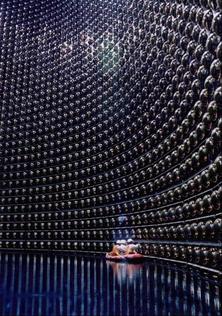
Ed Kearns, James Stone, Lawrence Sulak
As a sequel to the combined effort of the two earlier deep underground ring-imaging detectors, IMB and Kamiokande, Super-Kamiokande started recording data deep inside a lead and zinc mine in the Japanese Alps in 1996. The detector is a 40-meter high by 40-meter diameter stainless steel tank, filled with 50,000 tons of ultra-pure water. The walls of the tank are lined with 11,200 photomultiplier tubes, each an enormous 50 centimeters in diameter. One half of the surface of the tank is covered by photosensitive material. These tubes record the Cherenkov light from charged particles as they pass through the water.
Physicists in the US and in Japan designed Super-K to search for, in part, the radioactive decay of the proton, a rare event never before observed. Detecting proton decay would confirm the Grand Unified Theory of particle physics.
Though Super-K has yet to detected a single candidate, it observed something equally intriguing: convincing evidence that neutrinos have mass. Because neutrinos carry no charge, they rarely interact with other particles. Billions go through each of us every second without effect. But since Super-K is so large, it detects a handful of these neutrinos each week. Using the data collected by Super-K, researchers including Boston University physicists Jim Stone (US co-spokesman), Larry Sulak and Ed Kearns confirmed results from the two precursor experiments that about half the neutrinos expected were unseen.
Neutrinos come in three species – the tau neutrino, the muon neutrino, and the electron neutrino. Super-K discovered that these neutrino species transform into each other. If oscillations occur, muon neutrinos could transform into tau neutrinos, and the missing neutrinos observed by Super-K would be explained. This was documented in the 1999 Ph.D. thesis of Boston University graduate student Mark Messier. Quantum mechanically, for these oscillations to occur, the neutrino must have mass. Several experiments since this revelation in 1998 have reinforced this interpretation.
The discovery of massive neutrinos has forced theorists to rethink the Standard Model of particle physics; neutrino mass is not anticipated in this most accurate and predictive of theories. Further, with mass, the neutrinos in the universe account for nearly as much mass as all the stars. Hence, they would influence the formation of galaxies in the early universe. This discovery is the first indication of new physics beyond the Standard Model.
- The ATLAS Experiment at CERN
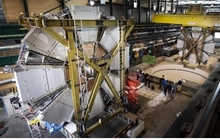
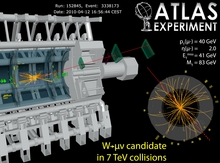
Steve Ahlen, Nafiun Awal, Clare Bernard, Kevin Black, John Butler, Lidia Dell'Asta, Kevin Finelli, Robert Harrington, Louis Helary, Michael Kruskal, Brian Alex Long, Jeremy Love, Karishma Sekhon, James Shank, Alex Sherman, Zhen Yan, Efe Yigitbasi, Saul Youssef
The ATLAS experiment is a large detector system developed by a collaboration of physicists from around the world to study very-high-energy proton-proton interactions at the Large Hadron Collider (LHC) at CERN, a laboratory for high energy physics near Geneva, Switzerland. Boston University personnel were involved in the construction and installation of the muon detectors for ATLAS. The detectors occupy a region the size of a five-story building and measure the trajectories of muons in a magnetic field with a precision of better than 1/10 of a millimeter. This permits precise determination of the muon momentum which is an important ingredient in searches for new phenomena at the TeV energy scale. Boston University has also played a leading role in the development of computing and analysis tools.
- The DØ Experiment
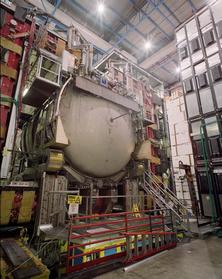
The DØ experiment studies proton-antiproton collisions at the world’s highest energy accelerator, the Fermilab Tevatron. These collisions release energy equivalent to 2000 times the proton mass. The DØ detector is a large, highly sophisticated instrument that measures the fragments of these collisions and allows scientists to study the structure of matter at these high energies. According to our current understanding, the basic constituents of matter are quarks and leptons. All the matter surrounding us is made of the lightest quarks, called up and down, and the lightest leptons, the electron and its neutrino. However there exist two additional families of quarks and leptons with identical properties, except much larger masses. The heaviest of the quarks, the "top" quark, was discovered in 1995 by the DØ and CDF collaborations at Fermilab. The top quark turned out to have an extraordinarily large mass, approximately the same as an entire gold atom. Particle physicists believe that its further study will provide clues to the origins of mass. The members of the Boston University DØ group were actively involved in the discovery of the top quark and the study of the carrier of the weak force, the "W boson". The group is now participating in the second data-taking run which began in 2001 and will continue until 2009. During this run, thousands of top quarks will be created, allowing a detailed study of the properties of this intriguing particle. The data from the Fermilab Tevatron will also provide the best opportunity until the LHC begins operation to find the Higgs boson and new physics beyond the standard model. The Boston University group has taken leadership roles in the construction of the muon detector system and the silicon microstrip tracker, the development of algorithms to identify bottom quarks and muons, and the "Top and Higgs Physics" analysis group. The group has designed and built a significant fraction of the electronics for the muon system trigger, the silicon track trigger, and the central fiber tracker trigger. The group’s physics interests center on the top quark and the search for new particles and forces beyond the standard model.
- The MACRO Experiment: Monopole Astrophysics and Cosmic Ray Observatory
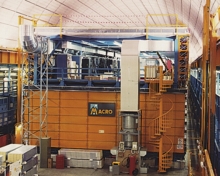
Ed Kearns, James Stone, Lawrence Sulak
The deep underground MACRO detector operated at the Laboratori Nazionali del Gran Sasso in Abruzzo, Italy from 1990 to 2000. MACRO had a geometrical acceptance of 10,000 square meters at an average depth of 3.8 kilometers of water equivalent under the mountainous overburden of the Gran Sasso d'Italia. The MACRO detector was used to research several topics. The specialty of MACRO was the search for magnetic monopoles: particles with bare north or south magnetic charge. These particles are a natural consequence of Grand Unified Theories, which also predict that the monopole will be very massive, perhaps 10 to the power 16 GeV. Such particles can only be produced by the intense energies available during the big bang. MACRO operated like a giant Time-Of-Flight counter to detect the unique signature of a slow moving but penetrating massive particle. It was equipped with tanks of liquid scintillator, planes of streamer tubes and plates of track etch material in the hopes of recording a convincing signature from a single candidate event. MACRO's high-resolution tracking and timing were also used to perform high statistics measurements of cosmic ray muons; in particular, the scintillator timing was used to distinguish upward going muons produced by neutrino interactions in the rock. This was an opportunity to investigate the possible flavor oscillation of massive neutrinos as suggested by the atmospheric neutrino puzzle, and MACRO was the first experiment to independently confirm the atmospheric neutrino oscillation signal seen by Super-Kamiokande.
 Physics (Internal)
Physics (Internal)